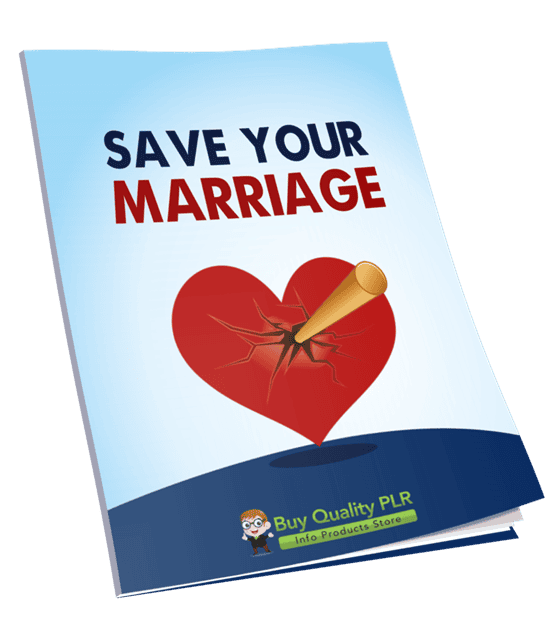
Save Your Marriage PLR Course 26k Words
in PLR Checklists , PLR eBooks , PLR eCourses , PLR List Building Reports , Premium PLR , Premium PLR eBooks , Premium PLR Reports , Premium White Label Brandable PLR Coaching Courses , Private Label Rights Products , Relationships , Relationships PLR , Relationships PLR eBooks , Wellness PLR , Wellness PLR eBooksChoose Your Desired Option(s)
has been added to your cart!
have been added to your cart!
#saveyourmarriage #relationshipadvice #marriagehelp #loveandmarriage #selfhelpcontent #wellnessplr #plrcourse #plrcontent #marriagetips
Save Your Marriage PLR Course – Rebuild Love, Trust, and Connection
Transform Your Relationship, Rekindle Your Love, and Strengthen Your Marriage
Marriage is a journey filled with joy, challenges, and growth. But when trust is broken, communication falters, or intimacy fades, couples often feel lost and uncertain about the future. The Save Your Marriage PLR Course is a comprehensive, step-by-step program designed to guide couples through the healing, rebuilding, and strengthening process.
With 24,138 words of actionable content, this course equips you—or your audience—with the knowledge, exercises, and strategies needed to restore trust, improve communication, and rekindle emotional and physical intimacy.
Whether you’re a relationship coach, content creator, blogger, or digital product entrepreneur, this PLR course is fully editable, ready to launch as a standalone product, bundle with other self-help materials, or offer as part of a coaching program.
Presenting…
Save Your Marriage PLR Course 26k Words
Why This Course is Essential
Many couples struggle silently with relationship issues, unsure where to start or how to take meaningful action. Common challenges include:
- Broken trust due to past mistakes or miscommunications
- Difficulty expressing emotions without triggering conflict
- Declining emotional and physical intimacy
- Feeling disconnected, unsupported, or unappreciated
- Uncertainty about rebuilding a shared vision for the future
The Save Your Marriage PLR Course addresses these challenges with a structured, practical approach, providing tools, exercises, and guidance that couples can apply immediately. It’s designed to help couples move from frustration and disconnection to understanding, closeness, and renewed love.
Who This Course is For
This PLR course is ideal for:
- Relationship and marriage coaches seeking ready-made training content
- Therapists and counselors who want supplemental materials for clients
- Digital marketers or bloggers targeting the self-help, romance, or personal growth niches
- Couples seeking guidance to rebuild and strengthen their relationship
- Anyone who wants to turn relationship expertise into a product or program without starting from scratch
What You’ll Learn
The Save Your Marriage PLR Course is organized into five comprehensive modules, each with four actionable steps. Here’s a full breakdown:
Module 1: Rebuilding the Foundations of Trust
Goal: Establish the groundwork for a stronger, healthier marriage.
Step 1: Understanding What Broke Trust
- Reflect on the events, actions, or patterns that caused mistrust.
- Journaling exercises help identify emotions like betrayal, hurt, or fear.
Step 2: Taking Responsibility
- Learn to acknowledge mistakes without blaming your partner.
- Techniques for having honest, respectful conversations about past issues.
Step 3: Setting Boundaries for Healing
- Agree on boundaries that promote respect, safety, and emotional security.
- Create a clear, actionable plan to follow these boundaries consistently.
Step 4: Practicing Forgiveness
- Forgiveness is a journey, not a one-time act.
- Exercises to let go of grudges, forgive yourself, and move forward together.
Module Benefits:
Couples gain clarity about past issues, take accountability, and lay the foundation for restoring trust.
Module 2: Mastering Effective Communication
Goal: Transform how you talk, listen, and connect with your partner.
Step 1: Learning to Listen Actively
- Focus on understanding your partner instead of responding immediately.
- Techniques like paraphrasing reinforce empathy and validation.
Step 2: Expressing Feelings Without Blame
- Use “I feel…” statements to express emotions constructively.
- Reduce defensiveness and create safe dialogue spaces.
Step 3: Scheduling Regular Check-Ins
- Weekly discussions for sharing feelings, challenges, and progress.
- Tips to keep conversations productive and distraction-free.
Step 4: Learning Conflict Resolution Techniques
- Handle disagreements as a team rather than adversaries.
- Learn to pause heated arguments and revisit them calmly.
Module Benefits:
Improved communication skills lead to fewer conflicts, deeper understanding, and stronger emotional connection.
Module 3: Strengthening Emotional Intimacy
Goal: Build connection and closeness that go beyond surface-level attraction.
Step 1: Reconnecting Through Shared Memories
- Reflect on happy moments to rekindle fond emotions.
- Journaling and storytelling exercises enhance emotional bonding.
Step 2: Building New Experiences Together
- Try new activities that foster shared growth and enjoyment.
- Examples: cooking classes, hiking, dance lessons, or creative workshops.
Step 3: Creating Daily Rituals of Connection
- Small daily gestures, like morning hugs or nightly check-ins, reinforce closeness.
- Celebrate micro-moments of appreciation to build a habit of connection.
Step 4: Writing Love Notes or Letters
- Express admiration and affection through written words.
- Create personal, heartfelt surprises that strengthen emotional bonds.
Module Benefits:
Couples reignite passion, understanding, and closeness, forming a deeper emotional foundation.
Module 4: Reviving Physical Intimacy
Goal: Restore comfort, closeness, and passion in your physical relationship.
Step 1: Understanding Each Other’s Needs
- Identify individual preferences for touch, affection, and intimacy.
- Develop strategies for mutual satisfaction and respect.
Step 2: Creating a Safe Space for Intimacy
- Dedicate time and space free from distractions.
- Foster emotional safety to allow physical closeness to flourish.
Step 3: Taking Small Steps to Reconnect
- Begin with non-sexual touch, like hand-holding, hugging, or massages.
- Gradually increase intimacy as comfort and trust return.
Step 4: Celebrating Milestones Together
- Acknowledge progress, whether a small gesture or a date night.
- Strengthen positive reinforcement and motivation for intimacy growth.
Module Benefits:
Couples rebuild trust and affection, creating a more satisfying physical and emotional connection.
Module 5: Building a Future Together
Goal: Create a shared vision and long-term plan for your relationship.
Step 1: Setting Shared Goals
- Identify long-term dreams like travel, family planning, or financial objectives.
- Break goals into actionable steps to work toward together.
Step 2: Committing to Growth
- Support individual self-improvement and personal growth.
- Share insights and learning to enhance mutual development.
Step 3: Maintaining a Support System
- Build a network of friends, family, or professional help to support your marriage.
- Strategies for leveraging guidance without undermining autonomy.
Step 4: Celebrating Your Relationship Regularly
- Plan anniversary milestones, date nights, or small celebrations.
- Reflect on progress and reinforce emotional investment in the marriage.
Module Benefits:
Couples leave the course with a roadmap for long-term happiness, trust, and fulfillment.
Bonus Materials
- Save Your Marriage Checklist (705 words) – Quick reference guide summarizing course steps
- FAQs (1,121 words) – Answers to common questions about rebuilding marriages
- Salespage Copy (693 words) – Ready-to-use marketing copy for your PLR product
How to Use and Profit from This PLR Course
- Sell as a complete digital course for couples seeking relationship guidance.
- Break into smaller reports or mini-courses ($10–$20) targeting specific topics like communication, intimacy, or trust-building.
- Bundle with other relationship or self-help content ($47–$97) to create premium packages.
- Launch a membership site offering ongoing tips, exercises, and coaching.
- Convert to audio, video, or workbook formats for high-value products.
- Use excerpts as lead magnets to grow an email list or generate interest in premium programs.
- Flip into an e-book or coaching program for additional revenue streams.
Licensing Terms
Permissions:
- Sell, edit, and repurpose content
- Claim copyright with 75% modification
- Use in coaching, e-courses, membership sites, or digital products
Restrictions:
- No transfer of PLR rights
- Maximum affiliate commission: 75%
- Cannot give full content away for free
- Cannot bundle without an additional purchase
Why This PLR Course is a Must-Have
- 24,138 words of structured, actionable content
- Covers trust-building, communication, emotional intimacy, physical intimacy, and long-term relationship planning
- Includes checklists, FAQs, and sales copy
- Fully editable and PLR-ready for coaches, bloggers, or digital entrepreneurs
- Helps couples rebuild, reconnect, and create lasting love
Take action today and help couples restore their love, strengthen their bond, and create the marriage they’ve always dreamed of.
The Save Your Marriage PLR Course is your complete guide to turning relationship challenges into growth, connection, and lasting happiness.
has been added to your cart!
have been added to your cart!
Here A Sample of Save Your Marriage PLR Course
This course is designed to guide couples through actionable steps to rebuild trust, improve communication, and strengthen emotional intimacy. With practical advice, easy-to-follow exercises, and heartfelt guidance, you’ll learn how to navigate challenges and rediscover the love that brought you together.
Module 1: Rebuilding the Foundations of Trust
Step 1: Understanding What Broke Trust
Building a healthy and thriving marriage requires a foundation of trust. When trust is broken, it often leaves deep emotional scars that can make it challenging to move forward. This step is about reflecting on what caused the mistrust in your relationship and processing those emotions constructively. By gaining clarity about the past, you can set the stage for meaningful healing and growth.
Reflect on the Events or Patterns That Caused Mistrust
- Create a Quiet, Reflective Space
Set aside uninterrupted time in a calm and private space. This ensures you can reflect deeply without distractions. Consider using soft lighting, calming music, or even a quiet outdoor setting to foster focus. - Identify the Specific Incidents
Pinpoint the moments or actions that led to a breakdown in trust. Was it a single event, such as dishonesty, or recurring patterns, such as neglect or unmet promises?- Be as specific as possible. For example, instead of saying, “We argued a lot,” describe, “Our arguments often escalated because we avoided discussing finances.”
- Avoid assigning blame at this stage. The goal is to understand what happened, not to judge.
- Examine How These Incidents Made You Feel
Reflect on the emotions you experienced during those moments. Did you feel hurt, betrayed, ignored, or insecure? Acknowledging your feelings is essential to processing them fully.- Example: “I felt unimportant when my partner consistently dismissed my concerns about our time together.”
- Recognize the emotional impact without suppressing or minimizing it.
- Look for Underlying Patterns
Beyond individual incidents, consider if there were ongoing behaviors or situations that eroded trust over time.- Ask yourself: Were there repeated issues around communication, priorities, or external stressors?
- Understanding patterns can help you identify areas that need addressing in your relationship.
Write Down Your Feelings and Experiences in a Journal
- Choose a Dedicated Journal
Use a notebook or digital tool specifically for this process. Keeping these reflections in one place will make it easier to track your progress. - Structure Your Writing
Start with prompts to guide your journaling:- What specific events or behaviors led to mistrust?
- How did these experiences make me feel?
- What patterns or recurring issues contributed to this breakdown?
For example:
- “On [specific date], I felt hurt when my partner canceled our dinner plans without telling me. This wasn’t the first time it happened, and it made me feel like I wasn’t a priority.”
- Write Freely Without Judgment
Allow your thoughts and emotions to flow without censoring them. Writing honestly will help you process your feelings. Remember, this journal is a safe space for your emotions and insights.- If you struggle to start, use stream-of-consciousness writing: jot down whatever comes to mind, even if it seems disorganized.
- If you struggle to start, use stream-of-consciousness writing: jot down whatever comes to mind, even if it seems disorganized.
- Revisit and Reflect
After writing, take a moment to read through your entries. Highlight recurring themes or powerful insights.- Ask yourself: What emotions stand out the most? What patterns do I notice?
- Recognizing these can help you prepare for the next steps in healing.
Important Notes for International Course Creators
- Cultural Sensitivity: Acknowledge that trust and its dynamics may differ across cultures. For example, in some cultures, trust may be closely tied to family involvement or communal expectations. Frame the instructions so they resonate universally.
- Language Clarity: Use clear, neutral language to ensure accessibility for non-native English speakers. Avoid idioms or culturally specific phrases. For example, instead of saying, “Lay all your cards on the table,” use, “Be honest and open about your feelings.”
- Inclusivity: Encourage participants to reflect on their unique relationship dynamics, avoiding one-size-fits-all assumptions. For instance, some couples may experience trust issues related to extended family, while others may face challenges stemming from work-life balance.
Why This Step Is Critical
Understanding what broke trust is the cornerstone of rebuilding it. By reflecting on the past, couples gain clarity about the root causes of their issues. This clarity allows them to move forward with purpose and intention. Journaling, in particular, serves as both a therapeutic and practical tool, enabling participants to organize their thoughts and track their emotional journey.
When done thoughtfully, this step lays the groundwork for open, honest conversations in the next stages of the course.
Step 2: Taking Responsibility
Taking responsibility is a vital step in the journey of rebuilding trust in a marriage. It’s not about assigning blame but about acknowledging your role in the situation, understanding how your actions may have contributed to the breakdown of trust, and taking meaningful steps to make amends. This step fosters accountability, which is crucial for both partners in restoring a sense of security and moving forward with mutual respect.
Discuss Past Actions Honestly with Your Partner
- Prepare for the Conversation
Before discussing past actions, it’s important to prepare emotionally and mentally. This conversation is about honesty, vulnerability, and healing.- Set the stage by finding a quiet, comfortable place where you can talk without interruptions.
- Choose a time when both of you are calm, not during moments of heightened emotion or stress.
- Open with a Statement of Intention
Start the conversation by clearly stating your intention to have a constructive, honest discussion. This sets the tone for the conversation, showing your commitment to healing and understanding.- Example: “I want us to have an open conversation where we can both share our feelings and take responsibility for our actions. My goal is for us to move forward and rebuild trust.”
- Reaffirm that your goal is not to blame or accuse, but to understand and take ownership of your actions.
- Acknowledge the Impact of Your Actions
Be honest about how your actions or behaviors have affected your partner. This is where you reflect on the emotional and psychological impact you may have caused.- Take time to think about your partner’s feelings before speaking. Try to put yourself in their shoes.
- Example: “I understand that when I broke my promises about our time together, it made you feel neglected and unimportant, and I’m truly sorry for that.”
- Acknowledging the emotional impact shows empathy and helps your partner feel heard.
- Be Specific and Avoid Generalizations
When discussing past actions, be specific rather than general. Vague statements can lead to misunderstandings or make it difficult for your partner to process the conversation effectively.- Instead of saying, “I wasn’t a good partner,” say, “I failed to communicate with you clearly when I was overwhelmed, and that made you feel isolated.”
- Being specific helps both partners pinpoint what went wrong and creates a clearer path for improvement.
Focus on Accountability Instead of Blame
- Shift the Focus from Blame to Understanding
It’s natural to feel defensive or upset when discussing mistakes, but it’s crucial to shift the focus from blame to accountability.- Blame places responsibility entirely on the other person, which prevents growth and healing. Accountability, on the other hand, empowers both partners to own their actions.
- Remind yourself that you’re not trying to prove who’s right or wrong, but to acknowledge your part in the situation and work towards a solution together.
- Take Ownership of Your Actions
Own up to the actions or behaviors that contributed to the breakdown of trust. This requires vulnerability, which may feel uncomfortable but is essential for emotional growth.- Example: “I realize that I didn’t prioritize our relationship when I became consumed with work. That hurt you, and I should have made more effort to be present.”
- Instead of making excuses or justifying your actions, focus on the fact that your actions affected your partner. Avoid statements like, “I didn’t do that because you did this…” or “I only did that because I was upset.”
- Recognize the Role of Both Partners
While it’s important to take responsibility for your actions, it’s equally important to recognize that the relationship involves two people. Acknowledge your partner’s feelings, but also gently bring attention to how both of you contributed to the situation, if applicable.- This should be done with care, avoiding a tone that could sound accusatory. Instead, frame it in terms of shared responsibility for the relationship.
- Example: “I know that both of us have made mistakes, and I’m committed to making things right. I hope we can both reflect on what we can each do to improve.”
- Avoid Defensive Language
When discussing sensitive topics, it’s easy to slip into defensive language, but this can hinder progress. Phrases like “I didn’t mean to” or “I was just…” can deflect responsibility.- Instead, focus on acknowledging the impact of your actions and expressing regret without justifying your behavior.
- Example: “I see now how my actions hurt you, and I deeply regret that.” This shows that you’re willing to take full responsibility without offering excuses.
Ensure the Conversation Is Respectful
- Practice Active Listening
Effective communication isn’t just about speaking honestly—it’s also about listening actively to your partner’s perspective.- As your partner shares their feelings, listen carefully and attentively. Avoid interrupting or preparing your defense while they speak.
- Reflect back what you hear to show understanding, e.g., “It sounds like you felt betrayed when I lied about where I was. Is that right?”
- Active listening builds empathy and helps both partners feel valued.
- Stay Calm and Manage Emotions
It’s easy for emotions to escalate during difficult conversations, but maintaining composure is crucial to keeping the discussion productive.- If you feel yourself becoming defensive or upset, take a deep breath, pause, and give yourself time to process before responding.
- It’s okay to acknowledge your emotions, but always strive to communicate them respectfully. For instance, “I’m feeling upset, but I want to stay focused on listening to you.”
- Use “I” Statements Instead of “You” Statements
This is a key aspect of respectful communication. “You” statements can feel accusatory and lead to defensiveness, whereas “I” statements focus on your own feelings and experiences.- Instead of saying, “You never listen to me,” try saying, “I feel unheard when I don’t have the chance to explain myself.”
- This helps avoid triggering a defensive reaction and promotes a more respectful dialogue.
- Commit to Mutual Respect
Throughout the conversation, agree on maintaining a respectful tone and language. Even if the conversation gets difficult, agree to avoid name-calling, insults, or degrading remarks.- If at any point you or your partner feels disrespected or overwhelmed, it’s okay to pause the conversation and return to it later when both of you are in a calmer state of mind.
- The goal is to maintain mutual respect throughout, acknowledging that both of you are on the same team working toward a solution.
Why This Step Is Critical
Taking responsibility for past actions is a transformative process that fosters growth, understanding, and healing in a relationship. It goes beyond simply admitting mistakes; it’s about acknowledging the emotional impact of those mistakes and committing to a positive change. When both partners take accountability, they can rebuild a foundation of trust based on mutual respect, empathy, and a shared desire to grow together.
As international course creators, it’s important to ensure that these concepts are communicated clearly and respectfully across cultural contexts. Acknowledging personal responsibility and practicing respect in communication can help bridge gaps in understanding and create a more supportive learning environment for participants from diverse backgrounds.
Step 3: Setting Boundaries for Healing
Setting boundaries is a crucial component of the healing process in a marriage that has experienced a breach of trust. Boundaries provide structure, safety, and clarity to both partners. They ensure that both individuals understand the expectations in the relationship and can rebuild trust in a way that feels secure and mutually respectful. By establishing boundaries, you create a framework where both partners can grow individually and together, without the fear of repeating past mistakes.
This step is about more than simply establishing rules; it’s about creating an environment of respect, safety, and consistent action. For course creators catering to an international audience, it’s important to consider cultural perspectives on boundaries, as they may vary significantly from one region to another. However, the core idea of setting healthy and clear boundaries is universally relevant and can be applied to any relationship.
Agree on Boundaries That Promote Respect and Safety for Both Partners
- Initiate a Calm, Open Discussion
Before setting boundaries, both partners must agree to a calm and open conversation about their needs, feelings, and concerns. This conversation should take place in a quiet, private setting where both partners can speak openly without fear of interruption or judgment.- Approach the conversation with empathy, acknowledging that both of you are coming from a place of hurt and wanting to heal.
- Example: “I believe setting some clear boundaries will help us feel safer and more respected in our relationship. Let’s discuss what would make us both feel secure.”
- Understand Each Other’s Emotional Needs
Boundaries should be based on each partner’s emotional needs and the desire to create an environment of safety, respect, and trust. It’s important that both individuals take time to reflect on what they need to feel supported, respected, and secure in the relationship.- Start by discussing what made each of you feel unsafe or disrespected in the past and what changes you’d like to see going forward.
- Example: “In the past, I felt disrespected when important issues were dismissed. I need to feel heard and understood in our conversations.”
- Each partner should be encouraged to express their personal needs clearly and without interruption.
- Set Clear, Concrete Boundaries
The boundaries you set should be specific, clear, and actionable. Vague boundaries are difficult to follow and can lead to misunderstandings. For example, saying “we need to communicate better” is too vague; instead, define what “better communication” looks like in terms of actions.- Example: “We agree to set aside time every evening to check in with each other, without distractions, for at least 15 minutes.”
- Include boundaries around behaviors, communication, space, and emotional support, ensuring that both partners are comfortable with the expectations.
- Consider boundaries related to privacy, such as no checking each other’s phone or social media accounts, to rebuild trust.
- Respect and Validate Each Other’s Boundaries
Boundaries should be mutually agreed upon, and both partners must feel heard and respected in the process. This is not about imposing one person’s needs over the other’s but finding a middle ground where both partners can feel safe and respected.- Example: “I know that you need some time alone to recharge. I understand that this is important for your well-being, and I’ll respect your space when you need it.”
- Each partner should validate the other’s feelings and boundaries, acknowledging that both people’s needs are valid and important for healing.
Create a Plan to Follow These Boundaries Consistently
- Develop an Actionable Plan for Following Boundaries
A boundary without a plan is difficult to maintain. Both partners should come together to develop a clear, actionable plan that includes how they will implement the boundaries they have agreed upon.- This plan can include specific steps to follow on a daily, weekly, or monthly basis.
- Example: “We will make time to have a weekly discussion about how we’re doing with our boundaries, and if there’s anything we need to adjust, we’ll do so together.”
- The plan should also include guidelines for addressing boundary violations if they occur, such as openly discussing the issue and finding a solution.
- Incorporate Accountability Into the Plan
Accountability is essential for ensuring that boundaries are respected consistently. Both partners must hold themselves and each other accountable for maintaining the boundaries.- Agree to gently remind each other of the boundaries when necessary, and address any violations in a calm, non-accusatory manner.
- Example: “If one of us unintentionally breaks a boundary, we’ll pause the conversation and take a moment to reflect on why it happened, without blaming or criticizing each other.”
- This can also include acknowledging progress. For instance, “We’ve been really good about spending quality time together and checking in daily, which has made me feel more connected to you.”
- Create a Flexible Approach for Adjustments
Life circumstances change, and so do relationship dynamics. Both partners must be open to revisiting and adjusting the boundaries as needed. An effective boundary system allows flexibility without compromising the underlying respect and trust that is being rebuilt.- Schedule regular check-ins to discuss whether the boundaries are still serving both partners’ needs or if adjustments are necessary.
- Example: “Let’s revisit our boundaries every month to see if we’re both still feeling safe and respected, and adjust them if we need to.”
- Being flexible helps prevent resentment from building up and ensures that the boundaries remain relevant to both partners’ evolving needs.
- Commit to Consistency and Patience
Following through with boundaries requires patience and consistency. It’s essential for both partners to commit to maintaining their boundaries, even when things get challenging.- Keep in mind that healing is a gradual process, and breaking old patterns takes time. Be patient with each other as you both adjust to the new framework.
- Example: “I know it’s going to take time to get used to not interrupting each other, but I’m committed to practicing patience and listening carefully.”
- Remember that consistency is key to rebuilding trust, and small, consistent actions will create a strong foundation for the relationship.
Why This Step Is Critical
Setting and maintaining healthy boundaries is fundamental to healing a relationship after trust has been broken. Boundaries provide clarity, ensuring both partners understand what is acceptable behavior and what is not. They offer a structure that allows both individuals to feel emotionally safe, respected, and valued. Without clear boundaries, there’s a risk of repeating past mistakes and perpetuating feelings of insecurity and hurt.
For international course creators, it’s essential to recognize that cultural perceptions of boundaries may vary. For instance, in some cultures, personal space and privacy might have a different significance than in others. Be mindful of these differences when guiding participants through the process of boundary setting. Regardless of cultural differences, however, the core principles of mutual respect, accountability, and consistent action are universal and should be emphasized throughout the course.
Incorporating these boundaries into your relationship and following them consistently will help create the foundation needed for trust to be rebuilt. It demonstrates that both partners are committed to ensuring the relationship remains healthy and that their individual needs are met in a way that fosters respect and understanding.
Step 4: Practicing Forgiveness
Forgiveness is a vital step in the healing process after a betrayal of trust, and it’s one of the most challenging aspects of restoring a relationship. Forgiving your partner—and yourself—can feel like an impossible task, especially when emotions are raw. However, practicing forgiveness is not about forgetting what happened or excusing harmful behavior. It’s about letting go of the negative emotions that bind you to the past, allowing for healing, and giving your relationship a chance to move forward.
This step involves learning to embrace forgiveness as a journey, not an overnight fix. It’s important to acknowledge that both partners will experience setbacks, and it’s normal to struggle with forgiveness at times. For international course creators, it’s essential to understand that forgiveness can vary across cultures. In some societies, forgiveness may be seen as an act of strength, while in others, it may have religious or philosophical dimensions. Regardless of cultural differences, the concept of forgiveness as a path to emotional freedom is universally beneficial.
Learn to Forgive Yourself and Your Partner
- Recognize the Importance of Self-Forgiveness
Before you can forgive your partner, it’s crucial to learn to forgive yourself. You may have played a role in the breakdown of trust, whether it was through actions, decisions, or not recognizing the issues in the relationship sooner.- Self-forgiveness starts with self-compassion. Acknowledge that you are human and that everyone makes mistakes. You can’t change the past, but you can learn from it and make better decisions moving forward.
- Example: “I made mistakes, and I regret how they affected our relationship. I’m learning from them and will do better, and that starts with forgiving myself.”
- Encourage the partners in your course to reflect on their mistakes without harsh self-judgment. Only through this process can one begin to heal emotionally and restore balance in the relationship.
- Understand the Difference Between Forgiveness and Excusing Behavior
Forgiving your partner does not mean excusing harmful behavior or accepting actions that go against your values. Instead, forgiveness is about freeing yourself from the emotional weight of the past and allowing yourself to move forward.- Example: “I forgive you for your actions, but that doesn’t mean I approve of what happened. I’m choosing to release the negative emotions attached to it so I can heal.”
- In your course, explain that forgiveness is about emotional release, not justification. Both partners must understand that forgiving someone doesn’t mean forgetting the hurt, but rather, accepting the situation and deciding to not carry the burden of anger or resentment.
- Recognize That Forgiveness is a Process, Not a One-Time Event
One of the most important things to understand about forgiveness is that it’s not a single moment in time; it’s a process. Healing and forgiving take time, and the path to forgiveness often involves revisiting the pain before fully letting it go.- Example: “Forgiveness doesn’t happen in an instant. There will be days when the pain resurfaces, but that doesn’t mean you haven’t forgiven—it’s just part of the process.”
- Create space for course participants to understand that emotional healing requires patience. They should give themselves permission to feel hurt, angry, or sad, but also give themselves permission to release those emotions over time.
- Commit to Forgiving Yourself First
Forgiving yourself is the first step before you can truly forgive your partner. If you are holding onto guilt, shame, or resentment toward yourself, it will be difficult to let go of these feelings long enough to forgive your partner.- Reflect on your role in the relationship, even if you weren’t directly responsible for the breach of trust. Consider areas where you could have communicated better, supported your partner more, or addressed issues earlier.
- Example: “I forgive myself for not noticing the signs earlier, but I’m ready to move forward with more awareness and compassion.”
- Encourage course participants to practice self-compassion daily, using affirmations and self-reflection to let go of personal guilt.
Start Small by Letting Go of Minor Grievances and Building Toward Deeper Forgiveness
- Let Go of Minor Grievances First
Start by letting go of smaller, less significant issues in the relationship before attempting to forgive the bigger transgressions. Often, we carry minor grievances with us without realizing how much they accumulate and affect our emotional well-being.- Example: “It bothered me when you didn’t help with the household chores, but I’m choosing to let go of that and focus on the bigger picture of rebuilding trust.”
- Starting with the smaller grievances can help create a sense of progress and success, building the confidence needed to address more significant issues. In your course, encourage participants to make a list of minor grievances they can let go of and consciously choose not to hold onto.
- Establish a Mindset of Compassion and Understanding
To truly forgive your partner, you need to cultivate a mindset of compassion and empathy. Understand that your partner is also human and has made mistakes. They may be hurting too, and their actions might have been driven by fear, confusion, or pain.- Example: “I know that your actions came from a place of fear or misunderstanding, and while it hurt me, I understand that you were also struggling.”
- Encourage participants in your course to take time to reflect on the emotions and struggles their partner may have been facing at the time of the betrayal. This perspective can make it easier to move toward forgiveness and to release feelings of anger.
- Take Time to Reflect on the Positive Aspects of Your Relationship
While it’s natural to focus on the hurt and betrayal, try to balance your thoughts by reflecting on the positive aspects of your relationship. Remember why you fell in love, the good memories you’ve shared, and the reasons you want to heal the relationship.- Example: “While this situation has hurt me deeply, I also remember the good times we’ve had and the love we share. I want to heal so that we can experience more of those moments together.”
- This balance can help participants shift their focus from the negative to the positive, making forgiveness more attainable. Encourage them to write down positive memories or reasons they want to forgive their partner.
- Give Yourself and Your Partner the Time and Space to Heal
Forgiveness doesn’t happen in a vacuum; it requires time and patience. Allow yourself and your partner the time and space needed to process the emotions, think things through, and decide to forgive.- Example: “I will take time to reflect on everything we’ve been through. I know that I need time to heal, and so do you. I’m willing to give us that time.”
- In your course, stress the importance of not rushing the forgiveness process. Let participants know that healing is unique for each person, and it’s okay to take time before reaching full forgiveness.
Why This Step Is Critical
Practicing forgiveness is not easy, but it is one of the most essential aspects of rebuilding trust and healing a relationship. Holding onto anger, resentment, or bitterness only prolongs the pain and keeps both partners stuck in the past. Forgiveness frees both individuals from the emotional burden and allows them to create a fresh start.
For international course creators, it’s important to remember that forgiveness may be understood and approached differently depending on the cultural context. In some cultures, forgiveness is a deeply spiritual practice, while in others, it may be more psychological or relational. Regardless of the cultural lens, the act of forgiving—whether self-forgiveness, forgiving a partner, or both—is universally valuable for emotional healing.
By practicing forgiveness—starting with small grievances and gradually working toward deeper issues—both partners can reclaim emotional peace and move forward in a healthier, more trusting relationship. The process may take time, but the reward is a deeper connection and a stronger foundation for the future.
We’re also giving these extra bonuses
Save Your Marriage – Checklist

Save Your Marriage – FAQs

Save Your Marriage – Salespage Content

Package Details:
Word Count: 24 138 Words
Number of Pages: 91
Save Your Marriage – Bonus Content
Checklist
Word Count: 705 words
FAQs
Word Count: 1121 words
Salespage Content
Word Count: 693 words
Total Word Count: 26 657 Words
Your PLR License Terms
PERMISSIONS: What Can You Do With These Materials?
Sell the content basically as it is (with some minor tweaks to make it “yours”).
If you are going to claim copyright to anything created with this content, then you must substantially change at 75% of the content to distinguish yourself from other licensees.
Break up the content into small portions to sell as individual reports for $10-$20 each.
Bundle the content with other existing content to create larger products for $47-$97 each.
Setup your own membership site with the content and generate monthly residual payments!
Take the content and convert it into a multiple-week “eclass” that you charge $297-$497 to access!
Use the content to create a “physical” product that you sell for premium prices!
Convert it to audios, videos, membership site content and more.
Excerpt and / or edit portions of the content to give away for free as blog posts, reports, etc. to use as lead magnets, incentives and more!
Create your own original product from it, set it up at a site and “flip” the site for megabucks!
RESTRICTIONS: What Can’t You Do With These Materials?
To protect the value of these products, you may not pass on the rights to your customers. This means that your customers may not have PLR rights or reprint / resell rights passed on to them.
You may not pass on any kind of licensing (PLR, reprint / resell, etc.) to ANY offer created from ANY PORTION OF this content that would allow additional people to sell or give away any portion of the content contained in this package.
You may not offer 100% commission to affiliates selling your version / copy of this product. The maximum affiliate commission you may pay out for offers created that include parts of this content is 75%.
You are not permitted to give the complete materials away in their current state for free – they must be sold. They must be excerpted and / or edited to be given away, unless otherwise noted. Example: You ARE permitted to excerpt portions of content for blog posts, lead magnets, etc.
You may not add this content to any part of an existing customer order that would not require them to make an additional purchase. (IE You cannot add it to a package, membership site, etc. that customers have ALREADY paid for.)
Share Now!












